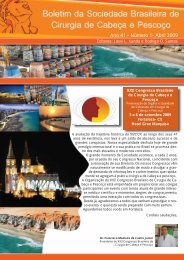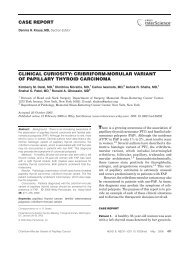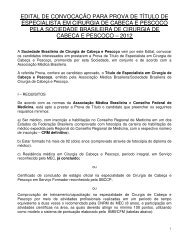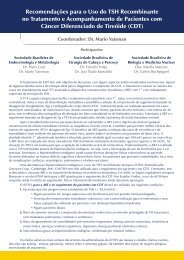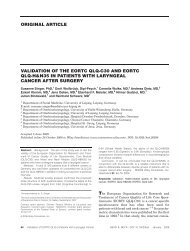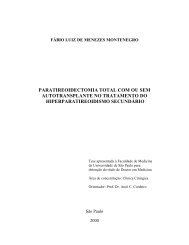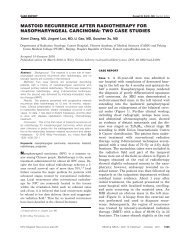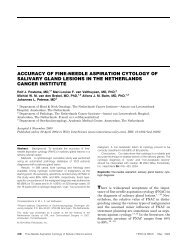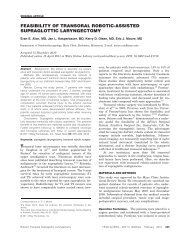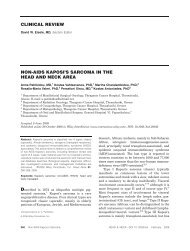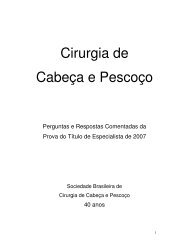Hypothyroidism caused by a nonvisible lingual thyroid
Hypothyroidism caused by a nonvisible lingual thyroid
Hypothyroidism caused by a nonvisible lingual thyroid
Create successful ePaper yourself
Turn your PDF publications into a flip-book with our unique Google optimized e-Paper software.
throat (ENT) examination. Routine laboratorytests revealed a mild normocytic, normochromicanemia (hemoglobin, 12.7 g/dL; mean corpuscularvolume [MCV], 86 fL; mean corpuscular hemoglobin[MCH], 26.2 pg/cell) and mildly elevatedcholesterol (207 mg/dL). Similar hemoglobin valueswere observed in the past, and his ferritinvalues were within normal limits. Thyroid functiontests revealed significantly elevated <strong>thyroid</strong>stimulatinghormone (TSH) levels with free serumtriiodothyronine (FT 3 ) and free serum thyroxine(FT 4 ) at the lower limit of normal values. Followup<strong>thyroid</strong> function tests revealed elevated TSHand low FT 4 , with FT 3 being at the lower limit ofnormal values He was restricted from continuedflying duty pending the completion of work-up ofhis <strong>thyroid</strong> function abnormality.His chest X-ray was found to be normal. Anultrasound examination of the neck revealed atrophyof both <strong>thyroid</strong> lobes with nonhomogenousconsistency and no lymphadenopathy. A technetium-99mscan revealed uptake at the tonguebase with no uptake at the neck or at other locations.A diagnosis of <strong>lingual</strong> <strong>thyroid</strong> was made,and L-thyroxine treatment was begun with a progressivedecrement in TSH values and disappearanceof the cough.DISCUSSIONLingual <strong>thyroid</strong> is the term applied to a mass ofectopic <strong>thyroid</strong> tissue located at the tongue baseat the midline, usually between the circumvallatepapillae and the epiglottis, in the area of theforamen cecum. It is believed to result from defectivedescent of the <strong>thyroid</strong> anlage from itsembryonic position at the base of the tongue to itsnormal pretracheal location, which usually occurson weeks 3 to 7 of embryonic development. Defectsin migration may lead to locations of the<strong>thyroid</strong> gland in other midline structures such asthe trachea, the esophagus, or near the hyoidbone. Hickman 1 reported the first case of <strong>lingual</strong><strong>thyroid</strong> in 1869, and 400 cases have been describedin the literature to date. This is the mostcommon benign mass found at the junction of theanterior two thirds and the posterior one third ofthe tongue. Postmortem studies indicate that upto 10% of people have <strong>thyroid</strong> tissue remnantsnear the base of their tongue, 2,3 although clinicallyapparent <strong>lingual</strong> <strong>thyroid</strong> is an unusualcondition, with a few hundred cases reported inthe literature. The estimated frequency of clinicallysignificant <strong>lingual</strong> <strong>thyroid</strong> varies between1/3000 and 1/10,000. 4 In 70% of these cases, the<strong>lingual</strong> <strong>thyroid</strong> is the only functional <strong>thyroid</strong>tissue. 5 <strong>Hypo<strong>thyroid</strong>ism</strong> is observed in an estimated33% of the cases and is commonly precipitated<strong>by</strong> increased physiologic demands. 6 Thisentity is much more prevalent in females, with amale-to-female ratio of 1:3 to 1:8. 7The pathogenesis of this condition remainsunknown. It is postulated that maternal anti<strong>thyroid</strong>antibodies may arrest the gland’s descentand predispose the patient to poor <strong>thyroid</strong> functionlater in life. 8 The incidence of <strong>thyroid</strong> diseaseamong family members of patients with <strong>lingual</strong><strong>thyroid</strong> is higher than among the populationat large. 9The symptoms of <strong>lingual</strong> <strong>thyroid</strong> are variableand depend on the patient’s age. Infants andyoung children are usually diagnosed on routinescreening and often have failure to thrive andmental retardation. Older children, adolescents,and adults are diagnosed after the onset of obstructivesymptoms, such as dysphagia, dysphonia,dyspnea, a cough worse on lying down, orlocal hemorrhage. Glandular hypertrophy occursin these populations as a response to the rise inTSH levels that is generated <strong>by</strong> the increase inmetabolic demand for <strong>thyroid</strong> hormone that occursin situations such as puberty, pregnancy,trauma, infection, or menopause. 10The initial evaluation of a <strong>lingual</strong> <strong>thyroid</strong>involves a thorough head and neck examination.The mass appears light pink to bright red or blue,and its surface can be smooth or irregular.Flexible or rigid endoscopy of the upper airwayis performed to determine the size of the <strong>thyroid</strong>and airway patency. Laboratory evaluationshould include <strong>thyroid</strong> function tests, which frequentlydemonstrate normal to low levels of T3and T4 and low levels of TSH and thyroglobulin.Hyper<strong>thyroid</strong>ism, although rare, has been reported.11 A technetium scan should be used toconfirm the diagnosis. These scans frequentlyshow radionuclide activity at the level of themouth and no apparent activity in the normalposition in the neck. CT provides an accuratemethod of determining the gland size, and it canbe performed without contrast, because the <strong>thyroid</strong>tends to accumulate iodine. 12 MRI is consideredthe method of choice to study <strong>lingual</strong><strong>thyroid</strong>s in a noninvasive way because of its multiplanarcapabilities and its high degree of softtissue resolution, which result in better delineationof the lesion. 13 Ultrasound is less dependableand is used to follow an enlarging component of996 <strong>Hypo<strong>thyroid</strong>ism</strong> from Nonvisible Lingual ThyroidHEAD & NECK November 2004



